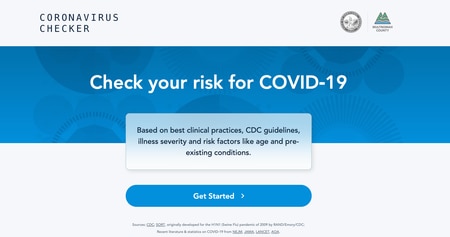 Home page for c19oregon.com (Screenshot)
Home page for c19oregon.com (Screenshot)
Coronavirus resources: CDC on the coronavirus, Oregon Health Authority resources, Washington County resources, Oregonian reporting on the coronavirus, OPB glossary of coronavirus terms, NYTimes free reporting on the coronavirus.
This article was originally published by the Oregonian/OregonLive, one of more than a dozen news organizations throughout the state sharing their coverage of the novel coronavirus outbreak to help inform Oregonians about this evolving health issue.
Here’s how you use c19oregon.com, the new Oregon-based online triage tool for coronavirus symptoms.
It evaluates the likelihood of whether you have COVID-19 through the symptoms you report.
If you need emergency care, then it helps direct you to a hospital with room to treat you if hospitals in the Portland metro area experience a surge of patients.
If you don’t have severe symptoms, it’ll encourage you to stay home.
On the home page, hit the blue “Get Started” bar.
The site is accessible in 15 different languages, including English.
The next page describes the terms and conditions for the use of the site, cautioning users that the guidance provided depends on the accuracy of information that users enter. It also urges the public not to disregard professional medical advice because of something read on the website.
Once you accept the conditions, the next page asks for your age.
 The ‘Getting Started’ page is the first page where the user enters information.
The ‘Getting Started’ page is the first page where the user enters information.
The next screen asks for your country of location and ZIP code.
This will give local emergency medical and public health workers the ability to track where people are reporting COVID-19-like symptoms and where hospitals and doctors may expect to be seeing more patients arriving.
 The site seeks the user’s location by zip code.
The site seeks the user’s location by zip code.
The next page asks users to check the symptoms they’re experiencing: from fever, couch, shortness of breath, to fatigue, body aches, headache, diarrhea, sore throat or none of the above.
 The site asks users to check the symptoms they are experiencing.
The site asks users to check the symptoms they are experiencing.
Based on the symptoms you identify, the next screen distinguishes if you are either at green, or low risk, of having coronavirus, yellow or medium risk, or red or high risk.
Each risk level recommends different steps be taken.
The site recommends those at green, or low risk, to stay home, avoid close contact with others, wash hands regularly and not your face.
 Low risk is green, based on symptoms or lack of symptoms identified on the online triage tool.
Low risk is green, based on symptoms or lack of symptoms identified on the online triage tool.
If you report some symptoms, such as fever and a cough, the site may request more information, such as whether you’re experiencing of any of these life-threatening symptoms: gasping for air, continuous pressure in the chest, can’t keep food or drink down for last 12 hours, feeling as if they might faint, or altered speech.
 Site may seek additional information once a user identifies the symptoms they’re experiencing.
Site may seek additional information once a user identifies the symptoms they’re experiencing.
If you’re experiencing life-threatening problems, the site will encourage you to call 911 or go to an emergency room.
If there’s a point where Oregon is experiencing a surge in coronavirus cases and hospitals are getting full, Oregon emergency medical and public health workers who have access to the data from the site will be able to add details on the website, directing you based on your ZIP codes which hospital to go to that has open beds.
 High risk, or a red result on the site will direct a user to call 9-1-1 or go straight to an emergency room.
High risk, or a red result on the site will direct a user to call 9-1-1 or go straight to an emergency room.
Or the site may send you to a screen to identify what pre-existing medical conditions you have.
Those could include: diabetes, emphysema, heart disease or failure, liver disease, or chemotherapy treatments.
 The site asks users if they have any pre-existing medical conditions.
The site asks users if they have any pre-existing medical conditions.
If you have have few symptoms but no prior medical condition and you’re young, you may be characterized as medium risk.
If so, the site recommends that you stay at home and isolate yourself unless your symptoms worsen. It also recommends that you avoid contact with others and wear a face mask to prevent spreading the illness to others.
But you’re still worried about your condition, the site may recommend you contact a nurse triage line run by Oregon Health & Sciences University Hospital. Local authorities are in continuing discussions with the hospital to provide that phone line.
You also are encouraged to try the symptom checker again if your symptoms worsen.
 Medium-risk or yellow classification.
Medium-risk or yellow classification.




